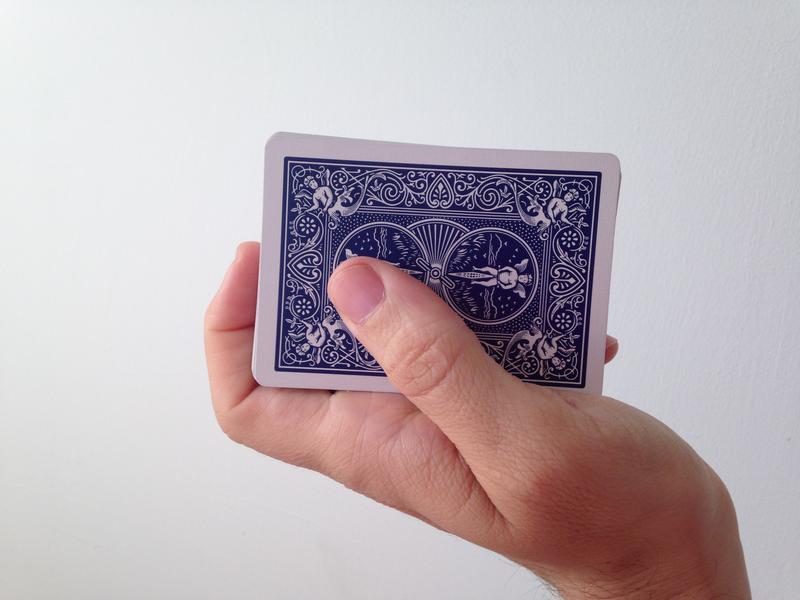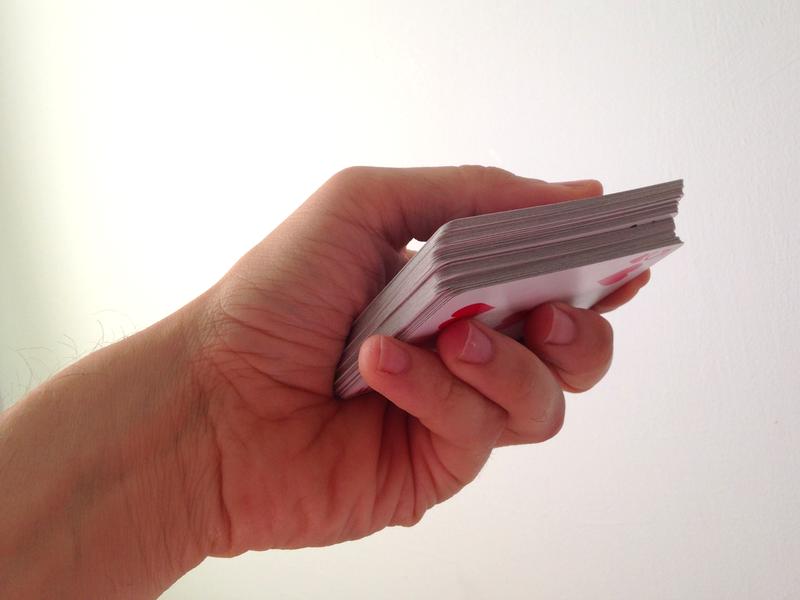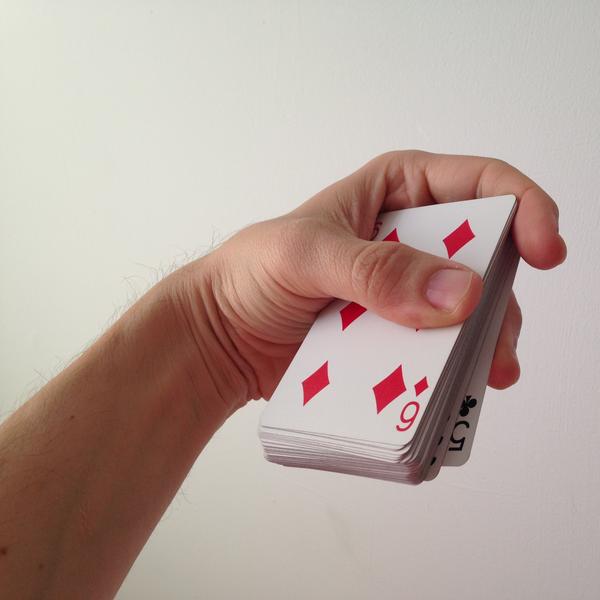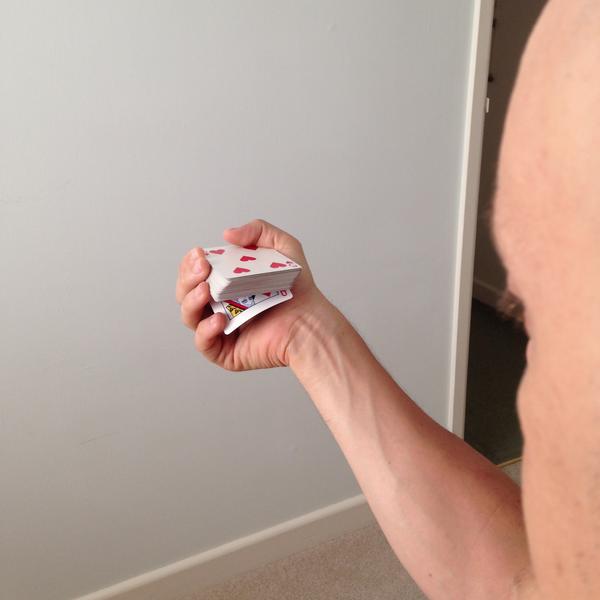As a website dedicated to learning magic, many of these pages attend to the efforts associated with gaining new skills and appreciations. As contended in the analysis of Fulves’ Self-Working Card Tricks ([1], see Three Tricks: A Reading), attempting to ‘follow’ written training instructions can entail a continual task of moving back and forth between abstracted directions and situated enactions. The basic approach in the Three Tricks pages was to regard instructions, not as standards that dictate what actions are required, but as resources that help make sense of actions and situations.
This entry juxtaposes audiovisual and textual instructions to advance some considerations associated with seeking to learn through the former.
Correspondence and Variance
The Overhand Shuffle 1 — Position of the pack in the hands
It’s essential that the cards are handled neatly and precisely, and the first requisite towards acquiring this neatness of execution is the position of the pack in the hands.
- Hold the hand half closed, palm upwards, and place the pack in it, face downwards so that the third phalanx of the index finger is bent against the outer left corner. The middle and ring fingers, slight bent, rest against the face of the bottom card; the little finger curls inwards so that its side rests against the inner end, and the thumb rests on the top card, its tip near the middle of the outer end.
The pack should slope downwards towards the left at an angle of about 45 degrees, its lower side resting along the palm of the hand. In this position the pack can be gripped between the index and the little fingers by pressing them against the opposite ends (Figure 1).
[…]
Figure 1
Two views of the left hand finger positions for an overhand shuffle.

(Own photographic simulations of Hugard & Braué's sketches)
The card handling instructions in Jean Hugard and Frederick Braué’s The Royal Road to Card Magic [2], a classic training manual, begins as shown in the Box. As in the case of the ‘self-working’ directions examined in Three Tricks, a central aspect of acting in alignment with these directions is the work of what Livingston has dubbed embodied ‘correspondence’ — in this case attempting to make hand movements and instructional details accord. As elaborated, the type of correspondence work needed can vary considerably between tricks, and developing skill (in part) consists of appreciating what kind of correspondence is necessary at each stage.
Just what was being corresponded with what, changed as I first attempted The Overhand Shuffle. Initially in reading the first line of Paragraph (1.), my efforts consisted of stretching out my handpalm upwards and positioning the cards above the palm. Not knowing what the ‘third phalanx of the index finger’ referred to though, I shifted to the left sketch and sought agreement between my hands and this representation. The subsequent working through (1.) entailed circulating between the text, my left hand and the left sketch, with the last of these serving as the reference guide for trying to establish the meaning of terms like ‘bottom’, ‘inwards’, ‘side’, ‘top’, ‘middle’, and ‘end’. Attempts at discernment consisted of varyingly angling my left hand to try to gauge it against what positioning could be seen in and inferred from the left side sketch. It was only after doing this for some moments that I realized the left and right hand sketches referred to the same hand position — just from different angles. I then rotated my hand around more freely in an effort to judge the positioning of my hand, fingers, and thumb against those given in both sketches.
In such a manner, visual imagery — in this case a simple sketch — can serve as a decisive resource in performing embodied actions. In this particular case, even with the limited imagery on offer, the details of the sketches were vital and accessible reference markers for understanding indeterminate positional terms contained in the written instructions. As the saying goes, “an image is worth a thousand words” [3].
Even for this reason alone, it is not surprising that audiovisual-based card trick instructions are so commonplace today. Platforms such as YouTube contain hundreds upon hundreds, if not thousands upon thousands of instructional magic tutorials. Despite this abundance, even those producing such videos can advocate the importance of learning card tricks through books. As Othmarius (my favorite magic tutorial YouTube channel!) contended, reading makes demands on the imagination to visualize details, subtleties and possibilities. Possessing a refined ability to imagine, he argues, is core skill set in performing magic.
One of the ways in which audiovisual aids have been developed is as adjuncts to texts. As Hugard and Braué explain to readers in the Introduction to the 2015 edition to The Royal Road to Card Magic, to ‘help you further with mastering the sleights, we have produced a complete series of videos’. These videos, viewed through scanning QR codes in the printed book, ‘demonstrate how each sleight should look when you have mastered it.’ While The Royal Road to Card Magic contains many descriptions of fully fledged tricks, no videos are produced for them. Instead, it is the enactments of the individual techniques of artifice (how to glimpse, shuffle, palm, lift cards) that are shown.
As a way into examining the kinds of work done to align with audiovisual instructions, I want to consider some aspects of using these videos as guides. If one image is worth a thousand words, then videos should be worth...well…many, many tens of thousands of words. And yet, the situation is arguably more complicated than this.
In the specific case of The Royal Road to Card Magic videos, an important prefatory remark to underscore is that they display sleights rather than provide step-by-step instructions on how to perform each technique. Individual videos typically only last for several seconds with the audio component predominantly overlaying summary descriptions of the sleight in question rather than conveying any instructional directives.
It is perhaps not surprising then that I engaged with the videos differently than the book’s written instructions. While the latter provided detailed statements on the positioning of cards and hands that often extended over several paragraphs, the videos could cover the very same manipulations in the flash of the eye. It is perhaps further not surprising that I oriented differently to the sequence of information. In the case of the written instructions, as noted in Three Tricks, upon initially attempting them I repeatedly stopped at points of uncertainty to scan ahead in the text to ascertain whether some difference between my execution and how I interpreted the instructions was germane. That was never the case in watching The Royal Road to Card Magic videos — their duration did not encourage this sort of perusal. Perhaps more interesting, I cannot recall ever pausing any other magic instructional videos upon initially performing them to forward ahead to check on the potential relevancy of an identified point of concern. In this way, as part of my learning, whereas the information contained in videos was treated as a flow, written instructions were treated as bitty.
The notion of flow is useful in other respects. In my working through the text and videos in The Royal Road to Card Magic, the variance between the details in each was an ongoing issue. Whereas — as illustrated through the above extract related to the positioning of the base hand for the overhand shuffle — textual instructions are often characterized by neatness and precision, video displays of magic are typically far messier affairs. Cards are not precisely aligned, fingers move around, hand movements vary in duration and distance, etc. In speaking tens of thousands of words, videos therein provide the basis for noting differences within the imagery shown as well as between the images and other instructional resources.
The kinds of work entailed in seeking to align with the videos in The Royal Road to Card Magic included designating text-video-sketch variances and assessing their significance for action. In general terms, variances can be given a wide range of meanings. Some might be regarded as irrelevant because they stem from comparing messy situated actions to written idealizations. Still others might be regarded as owing to some failure of comprehension on the part of the viewer. As a leaner seeking to emulate the featured sleights, a notable aspect in going through The Royal Road to Card Magic was the extent of variances I perceived between the videos and text. For many explanations I judged the variance to be ‘fundamental’; which is to say I came to doubt whether the written explanations could serve as a sufficient resource for achieving what was displayed in the videos.
Top-card glimpse 1
Take the pack in the left hand, as for dealing, but with the index finger curled over the outer end and the thumb lying flat against the left-side edge.
Gesture to someone, saying, ‘Will you help me?’ As you make this gesture, turn the back of the hand uppermost, bringing the deck face upwards. Push the top card to the right with the left fingertips; this will expose the inner index (Figure 45). Return the hand to its original position.
Figure 45 (Glimpsing the top card) and video


(Own reconstruction of Figure 45 and a video still)
For instance, one of the ways provided for secretly sighting (or ‘glimpsing’) a card was as shown in the Box here:
In watching the video, I came to doubt the relation between the in-book instructions and the video. That doubt was initiated by noting the different depictions of the little finger. Whereas in the video that finger is conspicuously pulling the bottom card down to expose its face, in the text and figure the little finger seems not to play a central role. I then noted differences between the placement of the hands in the figure and video (and that they were opposed hands) to assess if I could re-angle my left hand from the position depicted in the figure to achieve the equivalent of the positioning in the video. When that proved impossible, I then went back to the written instructions to determine if I had mis-interpreted the finger positioning or could make minor adjustments to my finger placements to end up in a place something like that given in Figure 45.
Fixing on the positioning of the little finger as the key reference point for comparison, it proved impossible to use the instructions to achieve a hand configuration even ‘akin’ to that in the video. Or maybe better expressed, part of the work involved in seeking to align with these instructional resources was making determinations of the sufficiency of points of similarity and difference between them so as to judge what resources were being provided in the first place. In this case, I concluded the two depictions must represent alternative methods for glimpsing the top card and thus they were not amenable for point-to-point comparison. Thus, one dimension of the work of acting in aligning with instructional resources is coming to a sense of what the information given serves as directions for. That might be for: the same sleight with just some situated variations, alternative ways of realizing a shared principle of misdirection, alternative ways of achieving the same visual effect for the audience, etc. In this way, working through explanations of sleights entailed a kind of learning of how to learn with them. It also raised many questions in my mind regarding whether or not the variances were part of a deliberate educational strategy.
Effect and positioning
As developed through the analysis of Fulves’ Self-Working Card Tricks in the Three Tricks: A Reading pages, written instructions can adopt a variety of orientations to the effects of tricks. Readers can be positioned as present in the room and sharing in the surprise of card revelations. Or they might be supplied with insider knowledge from the start of the instructions about what is to come. While the possibilities are many, as written accounts are not lived performances, I suggested that part of the work entailed in attempting them was envisaging how the manipulations would be experienced by others.
Video instructions too vary in how they position the learner. As in the case of the ‘Top-card glimpse 1’ discussed previously, the perspective shown might be that of the magician-insider. Herein, learners need to speculate about what onlookers will perceive. Where video instructions can exceed the possibilities for textual ones is in their ability to position learners as viewers to intended visual effects. A common set-up of audiovisual instructions is that they start with an enactment of the trick or sleight in question, and then proceed to offer step-by-step instructions for undertaking the necessary manipulations. Through this, learners-as-viewers become an audience to a performance. In other words, whereas reading involves imagining what is possible, when positioned as an audience member, videos enable you to experience what is possible. Those prospects might relate to the affective states of witnessing a sleight or trick (wonder, amazement, curiosity, etc.) or they might relate to the potential for a trick to be ‘pulled off’ at all. To watch a video that in some way fools you is to be assured that it is at least possible for you to likewise fool others. As the saying goes, ‘seeing is believing’.
And yet, the situation is arguably far more complicated than this too. Videos convey the possible, but more needs to be said about what they offer compared to written instructions. In reading books such as The Royal Road to Card Magic, there are many grounds for believing the sleights and tricks can be performed despite the way in which readers are compelled to imagine their undertaking: the authors are highly accomplished, the book has gone through multiple editions, the techniques given are suitable for beginners, many of the sleights and tricks have a long lineage, etc.
Videos might go further by relieving the need for imagination, but only in relation to the specific enactments shown. That a trick or sleight is seen to ‘work’ by the viewer (whatever that term might be taken to mean) is no guarantee that this can be repeated in another set of circumstances. The camera angle is the most obvious consideration bearing on whether the effect one experiences as a viewer can be achieved elsewhere as a performer. Questions about what the video demonstrates become especially acute given the commonplace (but not universal) practice in online tutorials that the tricks are done solely for the eye of camera (and therefore its specific angles). Especially as many online tutorials are filmed by individual magicians themselves, they don’t tend to involve others being present. Even if they did include an audience, doubt might well creep in about whether their response was, in one way or another, playing to the camera.
These considerations imply the specific enactment shown is not a general for-all-purposes demonstration. This point was driven home to me in practicing the trick ‘Topsy-Turvy Cards’; the first trick in The Royal Road to Card Magic and one that makes use of the overhand shuffle. Despite watching video after video instructional performance, I just could not undertake the critical card overturn without prominently displaying (‘flashing’) a card when I was practicing in front of a mirror. Only after making several attempts to adjust the instructions over the course of a number of days did I realize the issue was that I was closer to my mirror that the on-line instructors where to their cameras. I took a step further away from the mirror and the overturn seemed reasonably undetectable.
As videos are highly mediated forms of display, additional complications can be associated with what does not get shown in what is shown. This includes the multiple filming takes that might be required to achieve the desired effect. In this sense, the observable perfections of any instructional performance can be taken as grounds for doubting the applicability of what is being demonstrated.
As a result, for me, videos have taken on a kind of ‘haunted’ quality: their efforts to display are invariably bound up with the production of what is not, missing, absent, etc. Whether one or many angle shots, some or no spectators, etc., specific enactments necessarily creates a sense of that which remains outside of them.
The points in the last few paragraphs touch on wider cultural themes. Visual recordings — such as photographs and videos — are often regarded with a kind of doubleness. The common expression ‘seeing is believing’ signals the stock placed in them as true chronicles of events. Not only can visual records capture a scene, but some can become icons that speak to powerful truths — such as a video of a man standing in front of a tank at Tiananmen Square or a photograph hooded figure standing on a box at Abu Ghraib. And yet, as records, such visual images are also recognized as not the same thing as the events they seek to capture. By giving a particular line of sight or by foregrounding some objects, images can mislead. Also, what is included within the image frame marks the boundaries of what has been left out — be that intentionally or otherwise. And still further, not everyone might be treated as able to ‘see’ what is presented in front of them. It is just this sort of basic doubleness — genuine and contrived — that card tricks play upon, and indeed, require.
As I continue to learn magic, I plan to explore the kinds of witnessing that gets done as part of instructions and performances.
[1] Fulves, K. (1976) Self-Working Card Tricks. Dover publications, pp. 128. ISBN: 9780486233345.
[2] Hugard, J. and Braué, F. (2015) The Royal Road to Card Magic. Video Edition. Foulsham publications. ISBN: 9780486408439.
[3] Having made this point, as part of my practicing with The Royal Road to Card Magic, I was struck by the feeling of accomplishment and sense of command I experienced when I could adequately execute the written instructions without needing to watch the accompanying video.